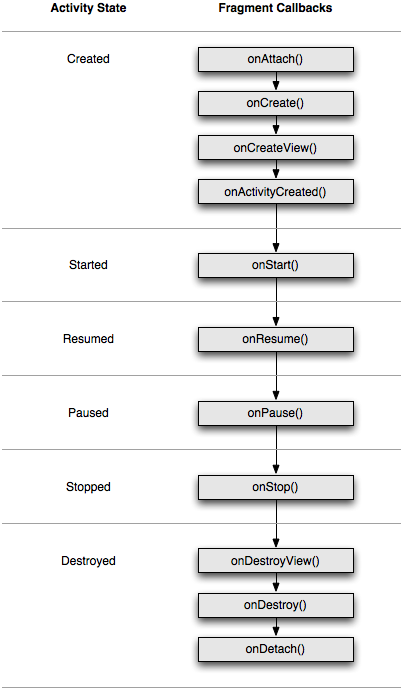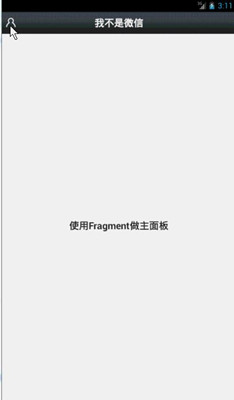源代码参考:360云盘中---自己的学习资料---Android总结过的项目---FragmentDemo.rar 本篇博客力求为大家说明 Fragment 如何产生,什么是 Fragment,Fragment 生命周期,如何静态和动态的使用Fragment,Fragment 回退栈,Fragment 事务;以及 Fragment的一些特殊用途,例如:没有布局的Fragment有何用处?Fragment 如何与 Activity 交互?Fragment 如何创建对话框? Fragment 如何与 ActionBar 集成等等。 一、Fragment 的产生与介绍 Android 运行在各种各样的设备中,有小屏幕的手机,超大屏的平板甚至电视。针对屏幕尺寸的差距,很多情况下,都是先针对手机开发一套 App,然后拷贝一份,修改布局以适应平板神马超级大屏的。难道无法做到一个 App 可以同时适应手机和平板么,当然了,必须有啊。Fragment 的出现就是为了解决这样的问题。你可以把 Fragment 当成 Activity 的一个界面的一个组成部分,甚至 Activity 的界面可以完全有不同的 Fragment 组成,更帅气的是 Fragment 拥有自己的生命周期和接收、处理用户的事件,这样就不必在 Activity 写一堆控件的事件处理的代码了。更为重要的是,你可以动态的添加、替换和移除某个 Fragment。 -------------------------------------------------------------------------------------------- 二、Fragment 的生命周期
可以看到 Fragment 比 Activity 多了几个额外的生命周期回调方法: 1.onAttach(Activity) 当 Fragment 与 Activity 发生关联时调用。 2.onCreateView(LayoutInflater, ViewGroup,Bundle) 创建该 Fragment 的视图 3.onActivityCreated(Bundle) 当 Activity 的 onCreate 方法返回时调用 4.onDestoryView() 与 onCreateView 想对应,当该 Fragment 的视图被移除时调用 5.onDetach() 与 onAttach 相对应,当 Fragment 与 Activity 关联被取消时调用 注意:除了 onCreateView,其他的所有方法如果你重写了,必须调用父类对于该方法的实现。 1. 当一个 Fragment 被创建的时候,它会经历以下状态. onAttach() onCreate() onCreateView() onActivityCreated() 2. 当这个 Fragment 对用户可见的时候,它会经历以下状态。 onStart() onResume() 3. 当这个 Fragment 进入“后台模式”的时候,它会经历以下状态。 onPause() onStop() 4. 当这个 Fragment 被销毁了(或者持有它的 Activity 被销毁了),它会经历以下状态。 onPause() onStop() onDestroyView() onDestroy() // 本来漏掉类这个回调,感谢xiangxue336提出。 onDetach() 5. 就像 Activitie 一样,在以下的状态中,可以使用 Bundle 对象保存一个 Fragment 的对象。 onCreate() onCreateView() onActivityCreated() 6. Fragments 的大部分状态都和 Activitie 很相似,但 Fragment 有一些新的状态。 onAttached() —— 当fragment被加入到activity时调用(在这个方法中可以获得所在的activity)。 onCreateView() —— 当activity要得到fragment的layout时,调用此方法,fragment在其中创建自己的layout(界面)。 onActivityCreated() —— 当activity的onCreated()方法返回后调用此方法 onDestroyView() —— 当fragment中的视图被移除的时候,调用这个方法。 onDetach() —— 当fragment和activity分离的时候,调用这个方法。 一旦 Activity 进入 resumed 状态(也就是 running 状态),你就可以自由地添加和删除 Fragment 了。因此,只有当 Activity 在 resumed 状态时,Fragment 的生命周期才能独立的运转,其它时候是依赖于 Activity 的生命周期变化的。 -------------------------------------------------------------------------------------------- 三、静态使用 Fragment 这是使用 Fragment 最简单的一种方式,把 Fragment 当成普通的控件,直接写在 Activity 的布局文件中。步骤: 1. 继承 Fragment,重写 onCreateView 决定 Fragemnt 的布局 2. 在 Activity 中声明此 Fragment,就当和普通的 View 一样 下面展示一个例子(我使用 2 个 Fragment 作为 Activity 的布局,一个 Fragment 用于标题布局,一个 Fragment 用于内容布局): <!-- 静态 Fragment 标题布局 --> <RelativeLayout xmlns:android="http://schemas.android.com/apk/res/android" android:layout_width="match_parent" android:layout_height="45dp" android:background="@android:color/holo_green_light" > <ImageButton android:id="@+id/ibTitleLeftBtn" android:layout_width="wrap_content" android:layout_height="wrap_content" android:layout_centerVertical="true" android:layout_marginLeft="15dip" android:background="@drawable/user" /> <TextView android:layout_width="fill_parent" android:layout_height="fill_parent" android:layout_alignParentTop="true" android:gravity="center" android:text="我不是微信" android:textColor="#fff" android:textSize="20sp" android:textStyle="bold" /> </RelativeLayout> <!-- 静态 Fragment 内容布局 --> <LinearLayout xmlns:android="http://schemas.android.com/apk/res/android" android:layout_width="match_parent" android:layout_height="match_parent" android:orientation="vertical" > <TextView android:layout_width="fill_parent" android:layout_height="fill_parent" android:gravity="center" android:text="使用 Fragment 做主面板" android:textSize="20sp" android:textStyle="bold" /> </LinearLayout> /** *Copyright(C) 2014 Beijing Oradt Ltd. For Digital Visiting Card 1.0 *File Name:TitleFragment.java *Description:标题 Fragment *Author: Xiao JinLai *Date:2014-12-12下午4:07:52 *History: Date: Author: Depiction: */ public class TitleFragment extends Fragment implements OnClickListener { private ImageButton mLeftMenu; @Override public View onCreateView(LayoutInflater inflater, ViewGroup container, Bundle savedInstanceState) { View tView=inflater.inflate(R.layout.fragment_title, container ,false); mLeftMenu=(ImageButton) tView.findViewById(R.id.ibTitleLeftBtn); mLeftMenu.setOnClickListener(this); return tView; } @Override public void onClick(View v) { switch (v.getId()) { case R.id.ibTitleLeftBtn: break; } } } /** *Copyright(C) 2014 Beijing Oradt Ltd. For Digital Visiting Card 1.0 *File Name:ContentFragment.java *Description:内容 Fragment *Author: Xiao JinLai *Date:2014-12-12下午4:24:56 *History: Date: Author: Depiction: */ public class ContentFragment extends Fragment { @Override public View onCreateView(LayoutInflater inflater, ViewGroup container, Bundle savedInstanceState) { return inflater.inflate(R.layout.fragment_content, container, false); } } <!-- 静态 Fragment 布局文件 --> <RelativeLayout xmlns:android="http://schemas.android.com/apk/res/android" xmlns:tools="http://schemas.android.com/tools" android:layout_width="match_parent" android:layout_height="match_parent" > <fragment android:id="@+id/ftTitle" android:name="com.xjl.fragmentdemo.TitleFragment" android:layout_width="fill_parent" android:layout_height="45dp" /> <fragment android:id="@+id/ftContent" android:name="com.xjl.fragmentdemo.ContentFragment" android:layout_width="fill_parent" android:layout_height="fill_parent" android:layout_below="@id/ftTitle" /> </RelativeLayout> /** * @ClassName: StaticFragementActivity * @author Xiao JinLai * @Date 2014-12-13 下午8:38:52 * @Description:静态 Fragement */ public class StaticFragementActivity extends Activity { @Override protected void onCreate(Bundle savedInstanceState) { super.onCreate(savedInstanceState); setContentView(R.layout.activity_static_fragment); } } 是不是把 Fragment 当成普通的 View 一样声明在 Activity 的布局文件中,然后所有控件的事件处理等代码都由各自的Fragment去处理,瞬间觉得Activity好干净有木有~~代码的可读性、复用性以及可维护性是不是瞬间提升了。 下面是效果图
-------------------------------------------------------------------------------------------- 四、动态使用 Fragment 上面已经演示了,最简单的使用 Fragment 的方式,下面介绍如何动态的添加、更新、以及删除 Fragment 为了动态使用 Fragment,我们修改一下 Actvity 的布局文件,中间使用一个 FrameLayout,下面添加四个按钮,嘿嘿,不是微信的按钮! <!-- 动态 Fragment 布局文件 --> <LinearLayout xmlns:android="http://schemas.android.com/apk/res/android" android:layout_width="match_parent" android:layout_height="match_parent" android:orientation="vertical" > <FrameLayout android:id="@+id/flContent" android:layout_width="match_parent" android:layout_height="0dp" android:layout_weight="1" > </FrameLayout> <include layout="@layout/bottom_bar"/> </LinearLayout> <!-- 底部四个按钮布局 --> <RelativeLayout xmlns:android="http://schemas.android.com/apk/res/android" android:id="@+id/rlTabBottom" android:layout_width="wrap_content" android:layout_height="wrap_content" android:layout_alignParentBottom="true" android:background="@drawable/bottom_bar" > <LinearLayout android:layout_width="fill_parent" android:layout_height="55dp" > <LinearLayout android:layout_width="0dp" android:layout_height="fill_parent" android:layout_weight="1" android:descendantFocusability="beforeDescendants" android:gravity="center" android:orientation="vertical" > <ImageButton android:id="@+id/ibTabBottomWeixin" android:layout_width="wrap_content" android:layout_height="wrap_content" android:background="#0000" android:clickable="false" android:src="@drawable/tab_weixin_pressed" /> <TextView android:layout_width="wrap_content" android:layout_height="wrap_content" android:text="微信" /> </LinearLayout> <LinearLayout android:layout_width="0dp" android:layout_height="fill_parent" android:layout_weight="1" android:descendantFocusability="beforeDescendants" android:gravity="center" android:orientation="vertical" > <ImageButton android:id="@+id/ibTabBottomFriend" android:layout_width="wrap_content" android:layout_height="wrap_content" android:background="#0000" android:clickable="false" android:src="@drawable/tab_find_frd_normal" /> <TextView android:layout_width="wrap_content" android:layout_height="wrap_content" android:text="朋友" /> </LinearLayout> <LinearLayout android:layout_width="0dp" android:layout_height="fill_parent" android:layout_weight="1" android:descendantFocusability="beforeDescendants" android:gravity="center" android:orientation="vertical" > <ImageButton android:id="@+id/ibTabBottomAddress" android:layout_width="wrap_content" android:layout_height="wrap_content" android:background="#0000" android:clickable="false" android:src="@drawable/tab_address_normal" /> <TextView android:layout_width="wrap_content" android:layout_height="wrap_content" android:text="通讯录" /> </LinearLayout> <LinearLayout android:layout_width="0dp" android:layout_height="fill_parent" android:layout_weight="1" android:descendantFocusability="beforeDescendants" android:gravity="center" android:orientation="vertical" > <ImageButton android:id="@+id/ibTabBottomSetting" android:layout_width="wrap_content" android:layout_height="wrap_content" android:background="#0000" android:clickable="false" android:src="@drawable/tab_settings_normal" /> <TextView android:layout_width="wrap_content" android:layout_height="wrap_content" android:text="设置" /> </LinearLayout> </LinearLayout> </RelativeLayout> /** * @ClassName: StaticFragementActivity * @author Xiao JinLai * @Date 2014-12-13 下午8:38:52 * @Description:动态 Fragement 主 Activity */ public class TrendsFragementActivity extends Activity implements OnClickListener { private WeiXinFragement mWeiXinFragement; private FriendFragement mFriendFragement; private AddressFragement mAddressFragement; private SettingsFragement mSettingsFragement; /** * 底部四个按钮 */ private ImageButton mTabBtnWeixin; private ImageButton mTabBtnFrd; private ImageButton mTabBtnAddress; private ImageButton mTabBtnSettings; /** * 用于对 Fragment 进行管理 */ private FragmentManager mFragmentManager; @SuppressLint("NewApi") @Override protected void onCreate(Bundle savedInstanceState) { super.onCreate(savedInstanceState); setContentView(R.layout.activity_trends_fragment); initViews(); mFragmentManager = getFragmentManager(); setTabSelection(0); } private void initViews() { mTabBtnWeixin = (ImageButton) findViewById(R.id.ibTabBottomWeixin); mTabBtnFrd = (ImageButton) findViewById(R.id.ibTabBottomFriend); mTabBtnAddress = (ImageButton) findViewById(R.id.ibTabBottomAddress); mTabBtnSettings = (ImageButton) findViewById(R.id.ibTabBottomSetting); mTabBtnWeixin.setOnClickListener(this); mTabBtnFrd.setOnClickListener(this); mTabBtnAddress.setOnClickListener(this); mTabBtnSettings.setOnClickListener(this); } @Override public void onClick(View v) { switch (v.getId()) { case R.id.ibTabBottomWeixin: setTabSelection(0); break; case R.id.ibTabBottomFriend: setTabSelection(1); break; case R.id.ibTabBottomAddress: setTabSelection(2); break; case R.id.ibTabBottomSetting: setTabSelection(3); break; } } /** * 根据传入的index参数来设置选中的tab页。 * */ @SuppressLint("NewApi") private void setTabSelection(int index) { // 重置按钮 resetTabBtn(); // 开启一个Fragment事务 FragmentTransaction tFTransaction = mFragmentManager.beginTransaction(); // 先隐藏掉所有的 Fragment,以防止有多个 Fragment 显示在界面上的情况 hideFragments(tFTransaction); switch (index) { case 0: // 当点击了消息tab时,改变控件的图片和文字颜色 mTabBtnWeixin.setImageResource(R.drawable.tab_weixin_pressed); if (mWeiXinFragement == null) { // 如果MessageFragment为空,则创建一个并添加到界面上 mWeiXinFragement = new WeiXinFragement(); tFTransaction.add(R.id.flContent, mWeiXinFragement); } else { // 如果MessageFragment不为空,则直接将它显示出来 tFTransaction.show(mWeiXinFragement); } break; case 1: // 当点击了消息tab时,改变控件的图片和文字颜色 mTabBtnFrd.setImageResource(R.drawable.tab_find_frd_pressed); if (mFriendFragement == null) { // 如果MessageFragment为空,则创建一个并添加到界面上 mFriendFragement = new FriendFragement(); tFTransaction.add(R.id.flContent, mFriendFragement); } else { // 如果MessageFragment不为空,则直接将它显示出来 tFTransaction.show(mFriendFragement); } break; case 2: // 当点击了动态tab时,改变控件的图片和文字颜色 mTabBtnAddress.setImageResource(R.drawable.tab_address_pressed); if (mAddressFragement == null) { // 如果NewsFragment为空,则创建一个并添加到界面上 mAddressFragement = new AddressFragement(); tFTransaction.add(R.id.flContent, mAddressFragement); } else { // 如果NewsFragment不为空,则直接将它显示出来 tFTransaction.show(mAddressFragement); } break; case 3: // 当点击了设置tab时,改变控件的图片和文字颜色 mTabBtnSettings.setImageResource(R.drawable.tab_settings_pressed); if (mSettingsFragement == null) { // 如果SettingFragment为空,则创建一个并添加到界面上 mSettingsFragement = new SettingsFragement(); tFTransaction.add(R.id.flContent, mSettingsFragement); } else { // 如果 SettingFragment 不为空,则直接将它显示出来 tFTransaction.show(mSettingsFragement); } break; } tFTransaction.commit(); } /** * 清除掉所有的选中状态。 */ private void resetTabBtn() { mTabBtnWeixin.setImageResource(R.drawable.tab_weixin_normal); mTabBtnFrd.setImageResource(R.drawable.tab_find_frd_normal); mTabBtnAddress.setImageResource(R.drawable.tab_address_normal); mTabBtnSettings.setImageResource(R.drawable.tab_settings_normal); } /** * 将所有的Fragment都置为隐藏状态。 * * @param transaction * 用于对Fragment执行操作的事务 */ @SuppressLint("NewApi") private void hideFragments(FragmentTransaction transaction) { if (mWeiXinFragement != null) { transaction.hide(mWeiXinFragement); } if (mFriendFragement != null) { transaction.hide(mFriendFragement); } if (mAddressFragement != null) { transaction.hide(mAddressFragement); } if (mSettingsFragement != null) { transaction.hide(mSettingsFragement); } } } 可以看到我们使用 FragmentManager 对 Fragment 进行了动态的加载,这里使用的是 replace 方法。下一节我会详细介绍 FragmentManager 的常用 API。 注:如果使用 Android3.0 以下的版本,需要引入v4的包,然后 Activity 继承 FragmentActivity,然后通过 getSupportFragmentManager获得 FragmentManager。不过还是建议版Menifest文件的uses-sdk的 minSdkVersion 和 targetSdkVersion 都改为 11 以上,这样就不必引入 v4 包了。 代码中间还有 4 个 Fragment 的子类。这四个 Fragment 类似,先贴两个看看。 /** * @ClassName: WeiXinFragement * @author Xiao JinLai * @Date 2014-12-21 下午8:09:01 * @Description:微信 Fragement */ public class WeiXinFragement extends Fragment { @Override public View onCreateView(LayoutInflater inflater, ViewGroup container, Bundle savedInstanceState) { return inflater.inflate(R.layout.fragement_weixin, container, false); } } /** * @ClassName: WeiXinFragement * @author Xiao JinLai * @Date 2014-12-21 下午8:09:01 * @Description:朋友 Fragement */ @SuppressLint("NewApi") public class FriendFragement extends Fragment { public View onCreateView(LayoutInflater inflater, ViewGroup container, Bundle savedInstanceState) { return inflater.inflate(R.layout.fragement_friend, container, false); } } -------------------------------------------------------------------------------------------- 五、Fragment 家族常用的API 1.Fragment常用的三个类: android.app.Fragment 主要用于定义 Fragment android.app.FragmentManager 主要用于在 Activity 中操作 Fragment android.app.FragmentTransaction 保证一些列 Fragment 操作的原子性,熟悉事务这个词,一定能明白 2.获取FragmentManage的方式: getFragmentManager() // v4中,getSupportFragmentManager 3.主要的操作都是 FragmentTransaction 的方法: FragmentTransaction transaction = fm.benginTransatcion();//开启一个事务 4.往 Activity 中添加一个 Fragment: transaction.add() 5.从Activity中移除一个Fragment,如果被移除的Fragment没有添加到回退栈(回退栈后面会详细说),这个Fragment实例将会被销毁。 transaction.remove() 6.使用另一个 Fragment 替换当前的,实际上就是 remove() 然后 add() 的合体 transaction.replace() 7.隐藏当前的 Fragment,仅仅是设为不可见,并不会销毁 transaction.hide() 8.显示之前隐藏的 Fragment transaction.show() 9.将此 Fragment 从 Activity 中分离,会销毁其布局,但不会销毁该实例 detach() 10.将从Activity中分离的Fragment,重新关联到该Activity,重新创建其视图层次 attach() 11.注意:常用Fragment的哥们,可能会经常遇到这样 Activity 状态不一致:State loss 这样的错误。主要是因为:commit 方法一定要在 Activity.onSaveInstance() 之前调用。 transatcion.commit()//提交一个事务 -------------------------------------------------------------------------------------------- 上述,基本是操作 Fragment 的所有的方式了,在一个事务开启到提交可以进行多个的添加、移除、替换等操作。 值得注意的是:如果你喜欢使用 Fragment,一定要清楚这些方法,哪个会销毁视图,哪个会销毁实例,哪个仅仅只是隐藏,这样才能更好的使用它们。 1.比如:我在 FragmentA 中的 EditText 填了一些数据,当切换到 FragmentB 时,如果希望会到 A 还能看到数据,则适合你的就是 hide 和 show;也就是说,希望保留用户操作的面板,你可以使用 hide 和 show,当然了不要使劲在那 new 实例,进行下非 null 判断。 2.再比如:我不希望保留用户操作,你可以使用remove(),然后 add();或者使用 replace() 这个和 remove,add 是相同的效果。 3.remove 和 detach 有一点细微的区别,在不考虑回退栈的情况下,remove 会销毁整个 Fragment 实例,而detach 则只是销毁其视图结构,实例并不会被销毁。那么二者怎么取舍使用呢?如果你的当前 Activity 一直存在,那么在不希望保留用户操作的时候,你可以优先使用 detach。 上述已经介绍完成了Fragment常用的一些方法,相信看完,大家一定清楚了Fragment的产生理由,以及如何使用Fragment,再根据API的讲解,也能明白,曾经为何觉得Fragment会出现一些列乱七八槽的问题,终究是因为没有弄清楚其生命周期。 由于篇幅原因,剩下的内容留到下一篇了。在下一篇,会介绍: 1、如何管理 Fragment 回退栈 2、Fragment 如何与 Activity 交互 3、Fragment 与 Activity 交互的最佳实践 4、没有视图的 Fragment 的用处 5、使用 Fragment 创建对话框 6、如何与 ActionBar,MenuItem 集成等

